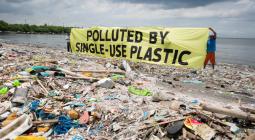Methane from landfills is detectable from space – and driving the climate crisis

An elusive climate menace is now easier than ever to see. In early March, a rocket launched into the sky with a satellite that spots methane emissions from space. MethaneSAT joined more than a dozen similar satellites now in orbit, scanning the Earth for pollution and feeding that information back to scientists, policymakers, industry and the public.
What story does the data tell? One of methane on the rise, or one of collective efforts that avoid the worst impacts of the climate crisis? Slashing methane is the most efficient way to slow global warming in our lifetimes. We have the chance – and the obligation – to do so.
When we think of methane, we often picture leaking pipelines or belching cows. But trash, organic waste decomposing in landfills, is the third largest source of human-caused methane pollution in the United States.
Thanks to huge advances in technology, a new study has brought more clarity to the landfill methane problem than ever before. The non-profit organization Carbon Mapper, with support from the US Environmental Protection Agency (EPA) and other researchers, observed methane emissions from hundreds of large landfills across the US by aircraft.
They detected significant emissions at more than half of the landfills they flew over. The emissions were often persistent: observed over multiple visits, spanning months, sometimes years. And they were large. About 80% of the emissions detected at landfills – more than 850 unique methane plumes – released at least 100kg of methane an hour.
That emission rate meets the “super-emitter” threshold that the EPA set for the oil and gas sector in its new standards. These large plumes are not fully captured in official inventories. On average, landfill emission rates calculated in the study over multiple visits were 1.4 times higher than the emissions that operators reported to the EPA.
This data is alarming, but the solutions are clear.
Let’s start with prevention. Keeping organic waste out of landfills – through waste prevention, food recovery and composting programs – is the most effective way to avoid future landfill methane generation, while benefiting communities. Each year, the average American family of four loses $1,500 to wasted food. We can all do a better job of buying what we need, eating what we buy, and donating or composting what's left.
And at landfills, there are simple, low-cost changes to avoid methane leaks. Early and expanded gas collection, better landfill covers, and additional accountability measures – more methane monitoring, more often – can help halt the release of methane to the atmosphere. We can encourage our local landfills to be part of the solution too, implementing best practices that better control methane and co-pollutants.
State and local governments, businesses, community groups, and all of us can help curb landfill methane emissions. But my former agency, in particular, can make a big difference.
The EPA is required by the Clean Air Act to revisit its landfill standards this summer, and I look forward to EPA’s leaders following their scientists’ research and moving swiftly to modernize air regulations. It just makes sense for the EPA to quickly adopt a rule that reflects the latest best practices in methane monitoring and control, while advancing waste prevention and organics recycling. By leveraging aerial and satellite methane data now available, EPA and cities and towns across the US and beyond can find and fix our largest leaks fast.
The benefits of tackling landfill emissions are huge. Stronger EPA standards would slash planet-warming methane and advance our climate goals. A recent state rule is estimated to curb landfill emissions by 25–50% once fully implemented. On a national scale, these methane cuts would be substantial. Controlling landfill methane also prevents the toxic, smog-forming gases released alongside it. This improves air quality, public health, and quality of life for the millions of people living near landfills, who are often low-income or people of color.
And keeping organic waste out of landfills brings further benefits: creating job opportunities in organics recycling, boosting soil health through compost application, and alleviating hunger through food donation. For both stronger landfill emission controls and organics diversion programs, the benefits far exceed implementation costs.
So the time is now for EPA and cities and towns across the country to advance smart policies that prevent and reduce the methane spewing from our landfills. Let's keep organics out of the trash, so landfills are not their final resting place. And let's tighten emissions controls nationwide, so small leaks don't become super-emitters.
With additional methane-detecting satellites scheduled to launch this year, we'll have more visibility into methane pollution than ever before. Let’s give these “eyes in the sky” less to see – and a good story to tell.
-
Gina McCarthy was the first White House national climate adviser, the 13th administrator of the US Environmental Protection Agency, and is managing co-chair of America Is All In







